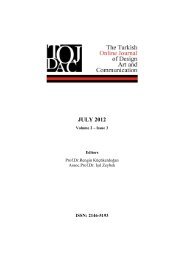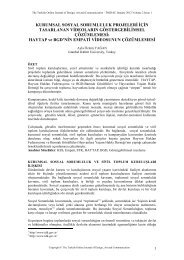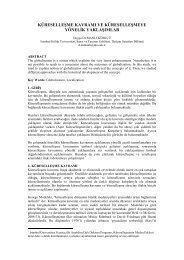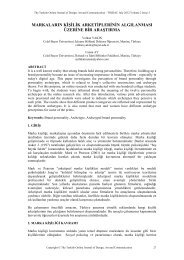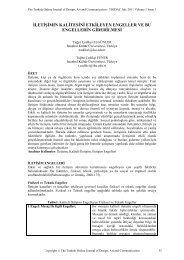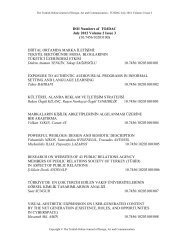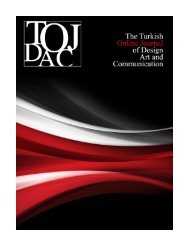aprıl 2012 - tojdac.org
aprıl 2012 - tojdac.org
aprıl 2012 - tojdac.org
Create successful ePaper yourself
Turn your PDF publications into a flip-book with our unique Google optimized e-Paper software.
The Turkish Online Journal of Design, Art and Communication - TOJDAC April <strong>2012</strong> Volume 2 Issue 2<br />
demonstrate behaviors described in each frame. The literature on Bolman and Deal’s leadership<br />
frames afford us to apply a deductive approach to examine the prevalence of frames in the<br />
Kuwaiti parliament members’ Twitter messages. Although there is a body of literature on Bolman<br />
and Deal’s leadership frames, the frames have been mostly used to assess <strong>org</strong>anizational leaders<br />
(Mossers & Walls, 2002; Sasnett & Ross, 2007; Bolman & Deal, 1984, 1991, 1997). Therefore,<br />
this study will investigate the four leadership frames by Bolman and Deal (1984) with some<br />
modification in the operationalization definition of each frame for them to be more relevent to<br />
asses political leaders. Structural frame. This frame emphasizes on effeciency and effectiveness.<br />
Structural leaders define clear goals, assign specific roles for their followers and supporters. This<br />
frame of leadership tries to coordinate internal process with external environment and coordinate<br />
specific activities with policies and procedures (Sassnet &Ross, 2007). Other research has also<br />
observed that critical analysis of issues and events was highly valued in the structural frame<br />
(Bolman & Deal, 1991). Zolner (2010) found that in structural frames, leaders frame problems in<br />
a way that they <strong>org</strong>inate from inappropriate structures and can be resolved through re<strong>org</strong>anization<br />
and restructuring.<br />
Human resource frame. The human resource frame focuses on needs of people. Leaders within<br />
this frame value feelings and relationships of people. This frame of leadership strives for a good<br />
relationship within the work environment (parliament). Sassnet &Ross (2007) observe that human<br />
resource frame is based on meeting the needs of the people through empowerment. Moreover,<br />
human resource leaders attempt to be responsive to people’s needs to gain loyalty. This frame<br />
emphasizes on support and empower people through participation( Bolman & Deal, 1991).<br />
Political Frame. Political frame is built on negotiation. Political leaders advocate and build their<br />
power bases through networking. In this frame, it is evident that leaders recognize the diversity of<br />
individuals, interests and compete for scarce resources (Sassnet &Ross, 2007). The political<br />
leader understands conflict and can deal with the different agendas interest groups may have. In<br />
addition, political frame usually consists of reasonable compromises for negotiaitions and<br />
conflict. Symbolic Frame. The symbolic frame emphasizes meaning, symbols and culture.<br />
Symbolic leaders value the subjective and achieve thier goals through interpretative rituals.These<br />
leaders rely on traditions and values. Zolner (2010) observed that the symbolic farme assumes<br />
that humans will create and use meaning to clarify confusion and predict mystery. In addition,<br />
leaders working in this frame instill enthusiasim and drama to their followers (Sassnet<br />
&Ross,2007; Bolman & Deal, 1991).<br />
3. PURPOSE OF THE STUDY<br />
The purpose of this study is to examine the utilization of leadership frames in Kuwaiti members<br />
of parliament’s Twitter messages, and to examine differences between the various political<br />
groups (Islamists, populists party, liberals, and independents). With these goals in mind, the<br />
following research questions were devised:<br />
RQ1: What is the most commonly used leadership frame (structural, symbolic, human resource,<br />
or political) by Kuwaiti parliament members<br />
RQ2: Does the use of structural, symbolic, human resources and political leadership frames vary<br />
by political group<br />
A second aim of this study is to compare the use of leadership frames in Kuwaiti parliament<br />
members’ Twitter messages and different topics or issues that they commonly Tweet about<br />
(political issues, for example, or social), and to consider the implications of the type of messages<br />
they post. The third research question is:<br />
Copyright © The Turkish Online Journal of Design, Art and Communication<br />
128



